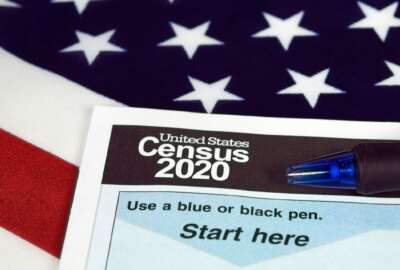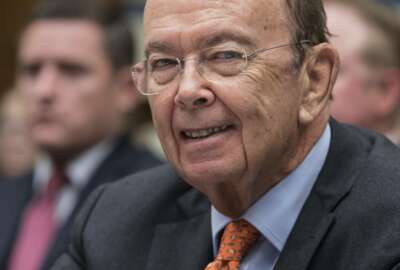
After windfall in omnibus, Census Bureau rolls out its first dress rehearsal
The clock is ticking for the Census Bureau to hand over the finalized list of questions it'll ask every household in the United States for the 2020 count.
The clock is ticking for the Census Bureau to hand over its finalized list of questions for every household in the United States for the 2020 count.
Two years out from the next decennial count, the agency entered the home stretch of delivering what it hopes will be the first tech-driven census.
In April, the Census Bureau will get to work on two major initiatives: First, it will give Congress a finalized list of all the questions that will be on the 2020 census form. Second, it will lay much of the groundwork for its first — and only — dress rehearsal for its new technology systems in Providence, Rhode Island.
Since March 16, Providence County households have been able to respond to the 2018 census test online at Census.gov or over the phone through an agency hotline. Starting April 9, the Census Bureau will mail paper questionnaires to area residents, and will follow up with non-responders a month later.
While Census recently received a $2.81 billion in funding in the omnibus spending bill that President Donald Trump signed into law Friday afternoon, the agency encountered budget shortfalls earlier in the 2020 count’s lifecycle. As a result, it had to scrap field tests in rural West Virginia and suburban Washington state.
Current methods unsustainable
Speaking on a March 19 panel about the state of the 2020 census, Indivar-Dutta Gupta, the co-executive director of the Georgetown Center on Poverty and Inequality, said the move from three to one technology tests poses some challenges.
“We’re going in with a lot less confidence and certainty at this point, although hopefully, we’ll learn a lot from the current end-to-end test in Providence, Rhode Island, about how well this internet and IT infrastructure is going to work,” Gupta said.
Last year, the Government Accountability Office put the 2020 count on its list of high-risk federal programs. And in the 2010 count, the Census Bureau tried to roll out some new technology before deciding to stick with an all-paper count.
But John Thompson, the most recent Census Bureau director who stepped down last summer, said at Monday’s panel that the agency cannot continue like this.
Until now, the decennial count has remained nearly unchanged since the 1970s: the Census Bureau prepares an address list, mails out a questionnaire to everyone on that list, collects and stores the responses electronically, then sends enumerators to follow up with households that did not mail back their questionnaires.
But hiring people to knock on doors across the country is a costly endeavor, and one that Thompson said does not make sense with the current U.S. population.
“As the population has gotten more complex, and you’re using a paper and pencil method, your only solution is you have to throw a lot more people at it — hire a lot more people and build a lot more infrastructure — and that’s what’s been raising the cost of the decennial census,” Thompson said.
In 2017, the Commerce Department estimated that the 2020 count will cost around $15.6 billion in total.

How the count will work
The Census Bureau has proposed a three-pronged approach to overhauling the 2020 count.
First, rather than having workers walk across the country collecting addresses, it will use a trove of geospatial data from local governments, the Postal Service and the National Geospatial-Intelligence Agency to build its address lists.
Second, it will allow the public to answer the 2020 census questionnaire online instead of mailing back a paper form. The agency will also allow people to answer the census over the phone for the first time.
“They do hope that a large part of the American population responds by the internet, because that will be producing data much more timely. It’ll be much less expensive,” Thompson said.
Third, the Census will equip enumerators going door-to-door with smartphones to record follow-up responses.
“The census is 10 questions, they fit on a smartphone very well, and when you have mobile technology, you can do really do a lot of things to more effectively manage your workforce,” Thompson said. “Like, you know somebody’s picked up their work, you know if they’re in the wrong area, you know if they’re filling out the questionnaires too quickly or too slowly. You can do a whole lot of things that really enhance the quality of the census.”
Drawbacks of digital
Despite the push to move the census count into the digital age, Terri Ann Lowenthal, a former staff director on the House Subcommittee on Census and Population and an adviser on census issues for President Barack Obama’s 2008-2009 transition team, said the agency should expect resistance from the public.
“Nobody disputes the need to modernize the census, but technology also brings cybersecurity risks — real or perceived,” Lowenthal said.
The federal government faces an uphill battle in getting the public to trust its data security after a number of high-profile data breaches, including the 2015 Office of Personnel Management, which compromised the personal information of more than 20 million people.
“People are more reluctant to provide their personal information online because of what they hear about cybersecurity threats,” Lowenthal said.
Furthermore, she said the push to a digital census leaves out low-income and rural populations that are typically underrepresented by the census.
People of color, she added, are also missed at disproportionately high rates.
“At the national level, Census undercounts and overcounts basically cancel each other out, and so the last census looked darn near perfect,” Lowenthal said. “But we don’t use Census numbers at the national level.”
Since the 2000 count, the Census Bureau has tried to reach out to under-reported communities through advertising campaigns and a community outreach programs.
But as the Census Bureau looks to finalize its list of questions, one thing that hurt its outreach efforts is a request from the Justice Department to include a question about citizenship on the 2020 count forms.
While the Census Bureau does not share its information with other federal agencies, including Immigration and Customs Enforcement, Lowenthal said the question could have a chilling effect on the response rate among the Hispanic population.
“That would derail, in my opinion, eight years worth of research testing and planning,” she said.
Testifying before the House Appropriations Committee on March 20, Commerce Secretary Wilbur Ross told lawmakers that his agency had not yet decided whether to include the citizenship question in the 2020 census.
Copyright © 2024 Federal News Network. All rights reserved. This website is not intended for users located within the European Economic Area.
Jory Heckman is a reporter at Federal News Network covering U.S. Postal Service, IRS, big data and technology issues.
Follow @jheckmanWFED




